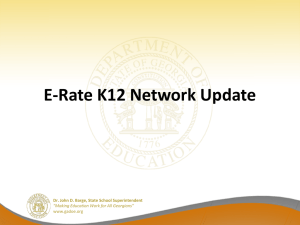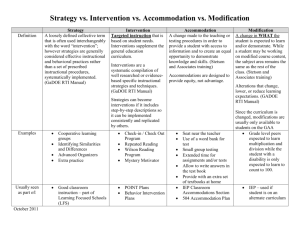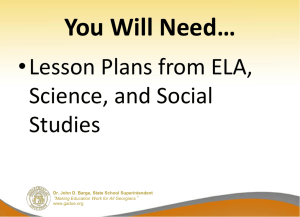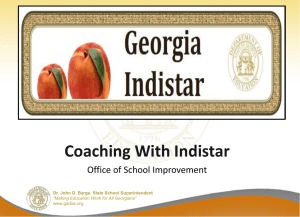Fidelity Tools - Georgia Association of Educational Leaders
advertisement
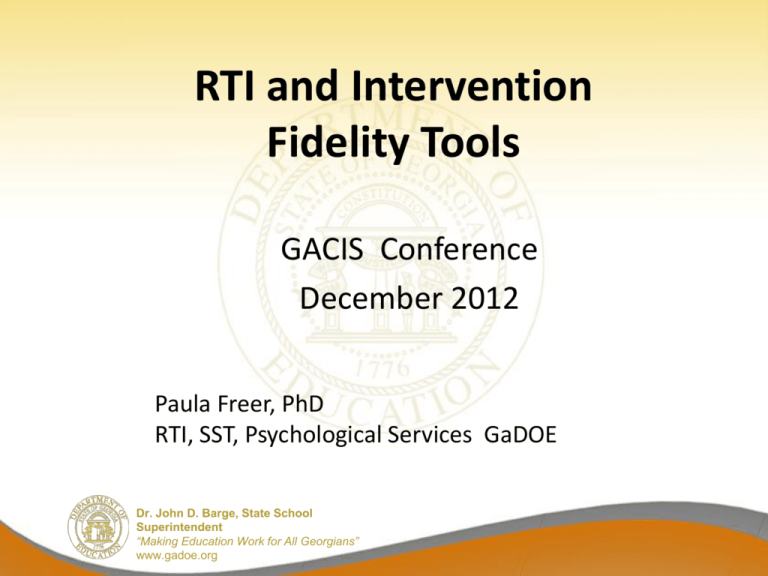
RTI and Intervention Fidelity Tools GACIS Conference December 2012 Paula Freer, PhD RTI, SST, Psychological Services GaDOE Dr. John D. Barge, State School Superintendent “Making Education Work for All Georgians” www.gadoe.org Session Objectives Tools to Support RTI Framework/Process • Curriculum and Instruction • Assessment • Data Decision Making and Interpretation • Problem-Solving Process • Interventions –Tools to Help You Build an Intervention Fidelity Framework in Your School and/or System Dr. John D. Barge, State School Superintendent “Making Education Work for All Georgians” www.gadoe.org 21st Century Context (Horner adapted, 2008) Science guided by our values and vision Programs and practices guided by our science School Improvement Dr. John D. Barge, State School Superintendent “Making Education Work for All Georgians” www.gadoe.org Math Early Intervention ALIGNMENT Literacy Response to Intervention/Prevention Using RTI to Align Resources Primary Prevention Universal Screening Wraparound Multi-tiered Interv Support Math Early Intervention Family Support Behavior Support (PBIS) Dr. John D. Barge, State School Superintendent “Making Education Work for All Georgians” (Fixsen, Blase, Horner, Sugai, 2008) www.gadoe.org Student Outcomes Progress Monitoring Systems to support practices Key elements: Ga Pyramid of Interventions (SSTAGE, 2010) Specially-Designed Learning: GPS access/extension, greater frequency of progress monitoring, specialized programs, methodology or instructional delivery ((Sped, EL, Gifted..) 4 Tier 3 Tier 2 Tier 1 SST-Driven Learning: In addition to Tier 1 and Tier 2 Different by including individualized assessments, formal progress monitoring, interventions tailored to individual needs, referral for specially- designed instruction if needed. Needs-Based Learning: In addition to Tier 1 Different by including specialized pyramids of intervention, greater frequency of progress monitoring of learning Standards-Based Classroom Learning : All students; implementation of the GPS through research-based practices, differentiated instruction and progress monitoring through multiple formative assessment and analysis of student work. School-Wide Positive Behavioral Interventions and Supports. Dr. John D. Barge, State School Superintendent “Making Education Work for All Georgians” www.gadoe.org Tier 1 is the Foundation for ALL Tiers Tier 1 is the foundation of the Pyramid. Tier 1 academic and behavioral supports are vital to the success of all Tiers. School-wide, grade level, class- wide data guides: Selection of Tier 1 research based strategies Universal Design for Learning Differentiation Instructional planning including core foundational skills Ongoing formative assessment Focus for coaching, consultation, feedback Common Core GPS Dr. John D. Barge, State School Superintendent “Making Education Work for All Georgians” www.gadoe.org RTI, Differentiation, and UDL Tier 4 Tier 3 Tier 2 Tier 1 Classrooms: Instruction is differentiated based on the readiness, interests, or learner profile data of specific students in the class District-wide/School-wide: Local curricula incorporate UDL Principles to maximize student access Statewide: CCGPS and GPS—WHAT Dr. John D. Barge, State School Superintendent “Making Education Work for All Georgians” www.gadoe.org HOW Universal Design for Learning (UDL) is a set of principles for curriculum development that give all individuals equal opportunities to learn at Tier 1. UDL provides a blueprint for creating instructional goals, methods, materials, and assessments that work for all students—not a single one-size-all solution but rather flexible approaches that can be customized and adjusted for individual needs. Source: Cast.org Dr. John D. Barge, State School Superintendent “Making Education Work for All Georgians” www.gadoe.org Universal Design for Learning IS incorporated in the initial unit and lesson planning to meet the needs of a wide diversity of students from the start. IS NOT retrofitted adjustments or modifications to units or lessons for specific students or groups of students. DOES provide access to a rigorous DOES NOT lower expectations or curriculum for all students, achievement for certain students or including ELs, SWDs, gifted groups of students. students and the kids next door. IS a framework for all students. Dr. John D. Barge, State School Superintendent “Making Education Work for All Georgians” www.gadoe.org IS NOT a special education initiative. UDL PD Resources on GPB UDL, Part 1: Principles of Universal Design http://www.gpb.org/education/common-core/udl-part-1 UDL, Part 2: Scaffolding Texts & Providing Explicit Strategy Instruction http://www.gpb.org/education/common-core/udl-part-2 Dr. John D. Barge, State School Superintendent “Making Education Work for All Georgians” www.gadoe.org 10 Connecting RTI to New Priorities: Aligning Educational Initiatives (Center on Instruction, 2011) The Center on Instruction hosted a webinar Oct-2011 discussing states’ implementation of new priorities and how these initiatives align with Response to Intervention (RTI): School Improvement Grants (SIG), College & Career Ready Standards (including Common Core State Standards), Meeting the needs of diverse student populations, Tools: • • • Connecting RTI to New Priorities: Aligning Educ. Initiatives/pdf Connecting RTI to New Priorities: Aligning Educ. Initiatives/ppt RTI Alignment Planning Packet/doc http://centeroninstruction.org/webinar-connecting-rti-tonew-priorities-aligning-educational-initiatives Dr. John D. Barge, State School Superintendent “Making Education Work for All Georgians” www.gadoe.org Essential & Core Concepts of RTI TIER 1 TIERs 2, 3, & 4 • Students receive high quality, research-based instructional strategies by qualified staff in general and special education. • Instructors assume an active role in students’ assessment in that curriculum. • School staff conduct universal screening of both academics and behavior. • School staff implement specific, research-based interventions to address the student’s difficulties. • Regular progress monitoring of student performance occurs. • School staff use progressmonitoring data and data decision rules to determine interventions’ effectiveness and needed modifications. • PL, Coaching and systematic assessment of the intervention fidelity or integrity of instructional implementation are ongoing and documented. (NRCLD,adapted for GA POI/RTI) Positive Student Outcomes are Dependent Upon • Fidelity of implementation of RTI Framework (at the school and system levels) •Degree to which interventions are empirically supported (evidence and/or research-based) • Fidelity of intervention implementation (at the interventionist and teacher level- classroom level) (Pierangelo & Giuliani, 2008) Dr. John D. Barge, State School Superintendent “Making Education Work for All Georgians” www.gadoe.org What is Fidelity? Fidelity of implementation refers to how closely the prescribed procedures of a process or intervention are followed (Mellard & Johnson, 2007). Fidelity and Integrity are two major terms used in RTI research. They are often used interchangeably. Dr. John D. Barge, State School Superintendent “Making Education Work for All Georgians” www.gadoe.org RTI Fidelity Matters Tier 4 Problem-Solving Process Fidelity of Progress Monitoring Fidelity of most intensive interventions Tier 3 SST Problem-Solving Process Individualized interventions Progress Monitoring Tier 2 Data teams Targeted group, standard protocol interventions Progress Monitoring Tier 1 Assessment and Universal Screening Instruction, Curriculum Walk-Through (e.g., instructional fidelity) Dr. John D. Barge, State School Superintendent “Making Education Work for All Georgians” www.gadoe.org RTI has the potential to help a school make better use of its resources for increasing overall student achievement However, achievement cannot be realized if screening, interventions, and progress monitoring procedures are not implemented with fidelity (NRCLD, 2006). Dr. John D. Barge, State School Superintendent “Making Education Work for All Georgians” www.gadoe.org SSTAGE RTI/POI Best Practice Rubric: Learning, Self-assessment and Planning Tool Includes five major components of the RTI/ POI framework: 1. Problem Solving Process 2. Assessment and Progress Monitoring 3. Instructional/Behavioral supports 4. Professional Learning / Teacher support 5. Parent/Family Communication & Involvement 17 What is Fidelity in Curriculum and Instruction? • Fidelity of implementation is the delivery of instruction and interventions in the way in which they are designed to be delivered (Gresham, MacMillan, Boebe-Frankenberger, & Bocian, 2000). • Examples of assessing instructional fidelity include: – Walk-Throughs – Peer observations (Barringer, ret. 2011) Dr. John D. Barge, State School Superintendent “Making Education Work for All Georgians” www.gadoe.org What is Fidelity of Assessment? Universal Screening -US & Progress Monitoring-PM Fidelity of the data collection process means that all individuals are collecting data following exactly the same procedures. (Barringer, 2011) Dr. John D. Barge, State School Superintendent “Making Education Work for All Georgians” www.gadoe.org Universal Screening and Progress Monitoring Universal screeners help show the “big picture” Whole school or large groups of students: Universally screened- using grade level CBM Probes: •Reading (1min. fluency, 2-5 min Maze Rdg. Comp) •Math (2-4 min computation fluency; concepts/applic 5-20 min) •Writing (5 min fluency) •Behavior (Frequency/type of office referrals, attendance…) Essential Q’s Universal Screening: •How are our 9th graders performing in reading using 9th grade probe? Progress Monitoring assesses targeted student skills to measure response to intervention using CBM Probes Progress monitoring- CBM Probes at student’s performance level Essential Q’s Universal Screening: •How is John- a 9th grader (who is at 6th gr level math) responding to PALS- Math interventionDr.using normed 6th grade math probe? John D. Barge, State School Superintendent “Making Education Work for All Georgians” www.gadoe.org Key Components (Barringer, 2011) Students’ Universally Screened & Progress monitored • CBM assessments (normed) • Results graphed against goals, comparison groups, and expected rates of weekly progress- all based on research/norms • Decisions regarding curriculum and instruction based on data (NRCLD, 2006) Dr. John D. Barge, State School Superintendent “Making Education Work for All Georgians” www.gadoe.org What is Fidelity of Data Decision-Making and Interpretation? • Fidelity means that the same decision making processes/rules are being applied to every case, across settings and across time • Fidelity means that the data is being interpreted the same way by all individuals engaged in interpretation (Barringer, 2011) Dr. John D. Barge, State School Superintendent “Making Education Work for All Georgians” www.gadoe.org Fidelity Activity -Universal Screening Interpreting Results Between and Within Campuses • What does the universal screening data tell you about these 6 schools? – What questions would you ask about certain school’s curriculum and instructional practices? – The readiness of each school for the Common Core? What is Fidelity of the Problem-Solving Process? • Fidelity means that the data is being interpreted the same way by all individuals engaged in interpretation. – Tier 1- School-wide and grade level data trends – Tier 2- Data teams, targeted small group school needs- standard protocol interventions – Tier 3- SST- Individualized student support plans – Tier 4- Specialized Programs- Gifted, EL, SWD… (Barringer, 2011) Dr. John D. Barge, State School Superintendent “Making Education Work for All Georgians” www.gadoe.org TIPS-FidelityChecklistRevised.pdf Dr. John D. Barge, State School Superintendent “Making Education Work for All Georgians” www.gadoe.org What is Fidelity of Intervention Implementation? • Degree to which interventions are empirically supported (evidence and/or researchbased) • Fidelity of intervention implementation (at the interventionist and teacher levelclassroom level) (Barringer, 2011) Dr. John D. Barge, State School Superintendent “Making Education Work for All Georgians” www.gadoe.org There is a great deal of confusing language being used to ‘qualify’ strategies, interventions, programs and practices Which is which? • Strategies ______________ • Interventions: – Scientifically-Based – Research-Based – Evidence-Based Dr. John D. Barge, State School Superintendent “Making Education Work for All Georgians” www.gadoe.org ______________ ______________ ______________ 27 Strategies Definition of Strategy A loosely defined collective term that is often used interchangeably with the word “intervention”; however strategies are generally considered effective instructional and behavioral practices rather than a set of prescribed instructional procedures, systematically implemented (GaDOE RTI Guidance). Examples (Classroom Instruction that Works, Marzano) – – – – – Cooperative learning Reinforcing effort and providing recognition Setting objectives and providing feedback Nonlinguistic representations Graphic organizers Dr. John D. Barge, State School Superintendent “Making Education Work for All Georgians” www.gadoe.org Interventions are NOT… • • • • • • • • Preferential seating Shortened assignments Parent contacts Classroom observations Suspension Doing MORE of the same Retention Peer helpers (informal) Dr. John D. Barge, State School Superintendent “Making Education Work for All Georgians” www.gadoe.org (John McCook, 2006) Understanding Scientifically-Based Interventions (NASP-Harn, 2007) ESEA Defines Scientifically Based Reading Research as: – (A) applies rigorous, systematic, and objective procedures to obtain valid knowledge relevant to reading development, reading instruction, and reading difficulties; and – (B) includes research that: • (i) employs systematic, empirical methods that draw on observation or experiment; • (ii) involves rigorous data analyses that are adequate to test the stated hypotheses and justify the general conclusions drawn; • (iii) relies on measurements or observational methods that provide valid data across evaluators and observers and across multiple measurements and observations; and • (iv) has been accepted by a peer-reviewed journal or approved by a panel of independent experts through a comparably rigorous, objective, and scientific review. (20 U. S. C. § 6368(6)) Dr. John D. Barge, State School Superintendent “Making Education Work for All Georgians” www.gadoe.org Intervention Science Scientists have produced programs and practices that can help students, communities & education systems – What Works Clearinghouse http://ies.ed.gov/ncee/wwc/ – Best Evidence Encyclopedia www.bestevidence.org – Promising Practices Network promisingpractices.net – SAMHSA- NREPP http://www.nrepp.samhsa.gov/ – Colorado Blueprints http://www.colorado.edu/cspv/blueprints/ Dr. John D. Barge, State School Superintendent “Making Education Work for All Georgians” www.gadoe.org Interventions • Definition of an intervention – Targeted instruction that is based on student needs. Interventions supplement the general education curriculum. Interventions are a systematic compilation of well researched or evidencebased specific instructional strategies and techniques (GaDOE RTI Guidance). Dr. John D. Barge, State School Superintendent “Making Education Work for All Georgians” www.gadoe.org Interventions Must Haves … • Be connected to a specific goal that is well-defined, observable and measurable • Be Matched to Student Need (skill or motivation deficit?; acquisition, proficiency/fluency, generalization, adaptation) • Have specific, defined, step-by-step directions so they can be: Implemented consistently Can be replicated so it can be researched • Include ongoing progress monitoring of the student’s response to the intervention • Fidelity, training, and coaching of the intervention • Scheduling to support interventions Dr. John D. Barge, State School Superintendent “Making Education Work for All Georgians” (Burns,M., www.gadoe.org Chris Riley-Tillman, T., & VanDerHeyden, A., 2012) Top Reasons for Academic Problems (Daly & Martens, 1997; EB Interv ret www. 2012 ) • The task is too hard for the • The student has demonstrated the student skill before, but has difficulty applying the skill in a new Acquisition Interventions manner • They have not had enough Generalization Interventions help doing the task Proficiency/Accuracy Interv’s • The student has not spent enough time doing the academic activity Proficiency/Speed Interv’s Dr. John D. Barge, State School Superintendent “Making Education Work for All Georgians” www.gadoe.org • The student does not want to do the academic task Motivation Interventions Intervention Tools Evidence Based Intervention Network Dr. T. Chris Riley-Tillman Educ., School, and Counseling Psych-Univ. of Missouri TOOLS *Evidence Briefs *Intervention Scripts *Videos http://ebi.missouri.edu/ Dr. John D. Barge, State School Superintendent “Making Education Work for All Georgians” www.gadoe.org Intervention Tools Intervention Central www.interventioncentral.org Reading Intervention Manual http://www.jimwrightonline.com/pdfdocs/broug e/rdngManual.PDF Peer Tutoring Reading Manual http://www.jimwrightonline.com/pdfdocs/prtuto r/peerTutorManual.pdf Dr. John D. Barge, State School Superintendent “Making Education Work for All Georgians” www.gadoe.org Reading Intervention www.helpsprogram.org •(HELPS) Program is to assist students with their reading fluency. Multiple studies evaluating the effects of the HELPS Program show that students who receive this program, compared to those who do not, significantly improve their reading fluency and reading comprehension (references and articles available upon request john_begeny@ncsu.edu) •In Georgia, with a four-tiered model, HELPS may be appropriate at Tiers 1-4. There is also a HELPS Program that can be used with small groups of students (typically used as part of Tier 1 and Tier 2 instruction), and a Spanish version of the program (Leamos para Avanzar) also exists. Dr. John D. Barge, State School Superintendent “Making Education Work for All Georgians” www.gadoe.org PALS TA: Iris Vanderbilt Website Gr K-1 PALS http://iris.peabody.vanderbilt.edu/palsk1/chalcycle. htm Gr 2-6 Reading PALS http://iris.peabody.vanderbilt.edu/pals26/chalcycle.htm HS PALS Module Dr. John D. Barge, State School http://iris.peabody.vanderbilt.edu/palshs/chalcycle.htm Superintendent “Making Education Work for All Georgians” www.gadoe.org Integrity of Progress Monitoring (Windram & Gibbons, 2011) Check: Is progress being monitored according to the plan? Are data collected and graphed on the intervention goal? Using aimline, expected rate of progress? If the progress monitoring is not happening as planned then: Give additional support OR Change the progress monitoring plan Dr. John D. Barge, State School Superintendent “Making Education Work for All Georgians” www.gadoe.org Top reasons why interventions FAIL? • Not implemented with Fidelity – Implemented Inconsistently – Implemented Incorrectly- missing steps, not implemented in the time it was designed (Ex: Do intervention for 20 min 1x wk when research designed for 45 min intervention- 3x wk) • • • • Not matched to student need Lack of Progress Monitoring Lack of training and coaching to support Lack of scheduling supports Dr. John D. Barge, State School Superintendent “Making Education Work for All Georgians” www.gadoe.org Essential Questions: Assessing Instructional Contexts and the Fidelity of Implementation What is fidelity? Whether an intervention was implemented as planned (Moncher & Prinz, 1991) Surface fidelity (Gersten, Fuchs, Compton,et al., 2005) Were key components implemented? Was adequate time allowed? Was the specified amount of material covered? Quality of delivery (Gersten, Fuchs, Compton,et al., 2005) Teacher behaviors Student behaviors Dr. JohnPotter D. Barge, School (Parisi, &State Whitcomb, NASP 2007) Superintendent “Making Education Work for All Georgians” www.gadoe.org Intervention Fidelity/Integrity Forms • Many research based interventions have those fidelity tools available http://www.aea11.k12.ia.us/educators/idm/che ckists.html http://www.oregonrti.org/node/33/ Dr. John D. Barge, State School Superintendent “Making Education Work for All Georgians” www.gadoe.org Intervention Implementation (Windram & Gibbons, 2011) How will intervention implementation fidelity be ensured? Select an intervention with high probability of success Communicate a clear plan to interventionists Provide specific training and support to interventionists. Directly observe intervention in action. Make adjustments to the plan if needed. Collect and graph data on the goal. Dr. John D. Barge, State School Superintendent “Making Education Work for All Georgians” www.gadoe.org Activity: Review Fidelity Data With your elbow partner, discuss: • What does your fidelity data tell you? • What follow-up steps would you see are needed? • How is this data important and how could you envision using it? Dr. John D. Barge, State School Superintendent “Making Education Work for All Georgians” www.gadoe.org Response to “Failure to Implement” Intervention? If the intervention is not implemented as designed, progress (or lack thereof) cannot be attributed to the specific plan or to student failure to respond (Windram & Gibbons, 2011;Kaufman & Flicek, 1995). Dr. John D. Barge, State School Superintendent “Making Education Work for All Georgians” www.gadoe.org How to Create an Intervention Checklist (Windram & Gibbons, 2011) Write out a brief description of the intervention Break down intervention into key steps Use concrete and practical language Put in table format (possible columns: intervention sequence: yes, no, NA) Dr. John D. Barge, State School Superintendent “Making Education Work for All Georgians” www.gadoe.org Dr. John D. Barge, State School Superintendent “Making Education Work for All Georgians” www.gadoe.org (Windram & Gibbons, 2011) Dr. John D. Barge, State School Superintendent “Making Education Work for All Georgians” www.gadoe.org Factors That Can Reduce Fidelity of Implementation of Intervention NRCLD 2006 Complexity—The more complex it is, the lower the fidelity (includes time to implement) Materials and Resources Required— Must be readily accessible Perceived and Actual Effectiveness— Intervention must be perceived by the teacher as effective and must match the teacher’s style Interventionists-- Number, expertise, and motivation matter Dr. John D. Barge, State School Superintendent “Making Education Work for All Georgians” www.gadoe.org Who Monitors Fidelity? • Someone trained in the intervention being monitored • Someone trained in structured observation • Someone trained in giving feedback and coaching • Someone who can develop positive, supportive relationships with teachers Dr. John D. Barge, State School Superintendent “Making Education Work for All Georgians” www.gadoe.org When Do You Monitor Fidelity/Integrity? • At the beginning, frequently • Provide staff immediate, brief, constructive feedback • Follow up with written feedback • After a solid protocol is established, less frequently • Always when the interventionist asks for help Dr. John D. Barge, State School Superintendent “Making Education Work for All Georgians” www.gadoe.org Positive Student Outcomes are Dependent Upon • Fidelity of implementation of RTI Framework (at the school and system levels) •Degree to which interventions are empirically supported (evidence and/or research-based) • Fidelity of intervention implementation (at the interventionist and teacher level- classroom level) (Pierangelo & Giuliani, 2008) Dr. John D. Barge, State School Superintendent “Making Education Work for All Georgians” www.gadoe.org Georgia Updates GaDOE- GPB RTI Series Coming Soon: Georgia’s Promising Practices in RTI which includes an Georgia’s RTI Leaders’ Panel Discussion and four teams representing the 2012 SSTAGE RTI STAR Award winning system , elementary, middle and high school. • Georgia’s RTI Leaders’ Panel: Realizing the Potential of RTI • System Level- Griffin Spalding County • High School Level- Ware Co High School • Middle School Level- Teasley Middle, Cherokee Co • Elementary School Level- Woodstock Elementary, Cherokee Co Dr. John D. Barge, State School Superintendent “Making Education Work for All Georgians” www.gadoe.org PL Fidelity Tools Fidelity of RTI process forms: http://www.rtinetwork.org/getstarted/checklist s-and-forms RTI Integrity Framework Tools/Webinar (27 min) http://www.rti4success.org/webinar/rtiintegrity-framework-tool-monitoring-andevaluating-rti-implementation-2721 Dr. John D. Barge, State School Superintendent “Making Education Work for All Georgians” www.gadoe.org PL Fidelity Tools National Center on RTI Fidelity of Implementation -RTI Framework Dr. Mellard • Webinar (56 min) • Power Point • Fidelity forms/tools http://www.rti4success.org/webinar/monitoringfidelity-rti-5615 Dr. John D. Barge, State School Superintendent “Making Education Work for All Georgians” www.gadoe.org IRIS Vanderbilt-PL Tools • The IRIS Center for Training Enhancements. (2010). Fidelity of Implementation: Selecting and Implementing EvidenceBased Practices and Programs Retrieved on [July 2012] from http://iris.peabody.vanderbilt.edu/fid/chalcycle.htm Dr. John D. Barge, State School Superintendent “Making Education Work for All Georgians” www.gadoe.org Intervention Central PL Fidelity Toolkit Intervention Integrity Part 1: Building Integrity into the Academic Intervention in the Design Phase http://www.interventioncentral.org/blog/rti-20elements-effective-interventions/interventionintegrity-part-1-building-integrity-academ Dr. John D. Barge, State School Superintendent “Making Education Work for All Georgians” www.gadoe.org Intervention Central PL Fidelity Toolkit Intervention Integrity Part 2: Using Multiple Measures to Track the Quality With Which Interventions Are Carried Out http://www.interventioncentral.org/blog/rti-20elements-effective-interventions/interventionintegrity-part-2-using-multiple-measures-t Dr. John D. Barge, State School Superintendent “Making Education Work for All Georgians” www.gadoe.org GaDOE and Fidelity GaDOE Chapter on RTI and Fidelity http://archives.gadoe.org/DMGetDocument.aspx/Chapter%209%20Fid elity%20of%20Implementation.pdf?p=6CC6799F8C1371F629C13CBF50 C40F3C933BFD2C32CE92F150B5DDF13E2D2061&Type=D GaDOE/SERVE Chapter on R-B Interventions http://archives.gadoe.org/DMGetDocument.aspx/Chapter%208%20Se ction%208.1%20Interventions.pdf?p=6CC6799F8C1371F6D1DCF9259B C8B9BC6C274BBA0BE05CD558A2342FEFB41093&Type=D Dr. John D. Barge, State School Superintendent “Making Education Work for All Georgians” www.gadoe.org State Guidance on Research and Evidence Based Resources GaDOE RTI Webpage http://www.gadoe.org/Curriculum-Instruction-and-Assessment/Curriculum-andInstruction/Pages/Response-to-Intervention.aspx RTI Guidance Manual 2011 http://www.gadoe.org/Curriculum-Instruction-and-Assessment/Curriculum-andInstruction/Documents/RTI%20document%20Full%20Text.pdf Parent GaPOI/RTI Brochure/Parent Chapter http://archives.gadoe.org/DMGetDocument.aspx/RTI%20for%20Parents%20Sep% 2018%202009%20Newsletter%20format.pdf?p=6CC6799F8C1371F6809F76CEBC2D 1082E99C433A5A790A1B42C22BA634A989A4&Type=D GaDOE SST Webpage http://www.gadoe.org/Curriculum-Instruction-and-Assessment/Student-SupportDr. John D. Barge, State School Superintendent Teams/Pages/default.aspx “Making Education Work for All Georgians” www.gadoe.org National Center on Response to Intervention http://www.rti4success.org/ This free site is supported by the US Department of Education, the National Center on Response to Intervention (RTI) provides information to individuals and technical assistance to state educational agencies across the country about RTI. Institute of Education Sciences (IES) - National Center for Educational Evaluation and Regional Assistance http://ies.ed.gov/ncee/wwc/publications/practiceguides/#r ti Spring of 2009 two practice guides on RTI were released, one on reading and one on mathematics. Other helpful information ranges from improving adolescent literacy to reducing behavior problems at the elementary school level. Dr. John D. Barge, State School Superintendent “Making Education Work for All Georgians” www.gadoe.org National Center on Student Progress Monitoring http://www.studentprogress.org/ This site provides information on the scientifically based practice of screening and monitoring students' skill development. Many different tools are available. Research Institute on Progress Monitoring www.progressmonitoring.org Florida Center on Reading Research http://www.fcrr.org This site provides multiple intervention ideas linked to the five essential components of effective early reading instruction. Interventions for individuals or small groups can be effective early reading in printed in their entirety. Dr. John D. Barge, State School Superintendent “Making Education Work for All Georgians” www.gadoe.org Thank you! You are the key to success! Together, We Can Make a Difference! GaDOE RTI, SST, Psych Services Contact pfreer@doe.k12.ga.us Dr. John D. Barge, State School Superintendent “Making Education Work for All Georgians” www.gadoe.org
